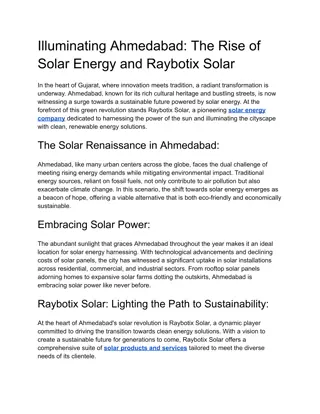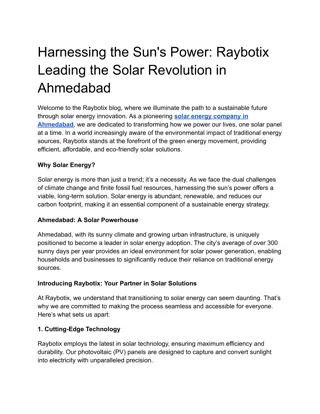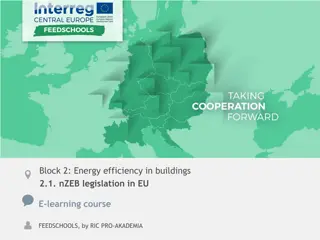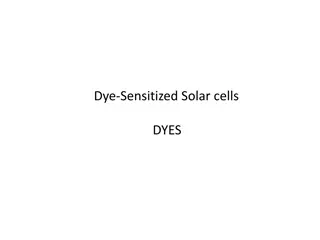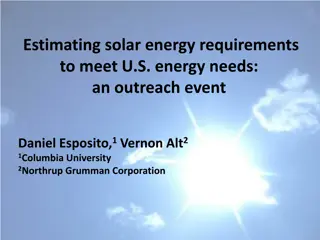Innovative Solar PV Integration for Sustainable Buildings
Palette PV offers a cutting-edge solution for integrating solar PV modules into buildings, overcoming challenges like cost and aesthetics. Their technology not only enhances energy efficiency but also reduces environmental impact through cleaner air and decreased dependency on traditional power sources.
Download Presentation

Please find below an Image/Link to download the presentation.
The content on the website is provided AS IS for your information and personal use only. It may not be sold, licensed, or shared on other websites without obtaining consent from the author. Download presentation by click this link. If you encounter any issues during the download, it is possible that the publisher has removed the file from their server.
E N D
Presentation Transcript
Company Information PALETTE PV Company Information Name Palette PV Headquarters Calgary, Alberta In Business since July, 2016 Main product or service Solar PV modules designed for exterior building-integration Annual Revenues $0 # of Full-time Employees 6 Owner/major share holder(s) Jane Doe (51%), employees (12%) & private investors (37%) Funds raised to date $3.05M (angel investors)
Define The Sustainability Problem Integrating PV modules into buildings faces several hurdles: Cost vs ability to harness energy (the levelized cost of electricity for BIPV is significantly higher than ground-mounted or rooftop PV, largely because they are unable to track the sun and generally have less exposure). Material limitations - Can be damaged by high winds and extreme precipitation. - Must adhere to strict material specifications and standards of construction industry. Today s solutions are not aesthetically pleasing Palette PV has developed an affordable module that is easily integrated to the roofs and sides of existing or new buildings. The technology leverages wavelength shifting technology and optimized microscopic solar cells, meets commercial building codes in all Canadian jurisdictions, can be tuned to nearly any colour (without efficiency losses), and can be installed on existing or new buildings.
Environmental Benefits - Qualitative BIPV installations result in cleaner air through the displacement of fossil fuel derived power generation. BIPVs can enhance buildings thermal and electrical management systems, leading to less dependency on the electrical and gas grid. By installing Palette BIPV, the technology will increase the proliferation of clean energy and provide building managers with a flexible solution to managing heat and cooling during both the summer and winter. Key assumptions Buildings generally use natural gas for heating in winter and electrically powered centralized air conditioning systems in the summer. Capacity factors adjusted for seasonality and technology s ability to gather solar energy over the course of a day.
Environmental Benefits - Quantitative Baseline: Building grid power for air conditioning and natural gas based heat Environmental benefits are based upon the number of square feet of modules sold for cladding or roofing We expect to sell roughly modules for 5,000 buildings at an average of 5,000 ft2per building in the next 5 years 0.01 MWh/ft2which at standard grid factors would result in 1.5E-6 kilotonnes of CO2e reductions with the deployment of each unit. This will result in emissions reductions of 37.5 kilotonnes of CO2e
Technology Palette PV has developed a range of applications for its modules, including a window mount, side of building mount, and rooftop mounts (for various structures including parking garages). Reflected Light Panel Cross-section Inbound Light Solar Energy Absorption Film Wavelength Shifting Film % Glass/Backing Material Polycarbonate/Glass Wavelength 605nm Shifting Air Gap 500nm 900nm Our printable electronics-based microscopic solar cells are built on plastic film and are optimized to convert light in the 900nm wavelength range Colour Tuned Reflected Light Current Collecting Conductors and Insulating Frame
Technology Conception and Initial Lab Trials First successful integration of wavelength shifting with PV cells First prototype module developed Current Stage securing funds to pursue demonstration project February 2018, University of Calgary June 2017, University of Calgary November 2018, University of Calgary Current, University of Calgary and New Office Space. Wavelength shifting film developed, modeled efficiency improvement of 0.75% Initial solar absorption film capable of producing charge of 0.001W/cm2 Able to harvest power from solar absorption film at annual 0.01MWh/sqft at standard solar test conditions Layered films utilized to enhance solar generation by 0.5% Printable solar absorption film process prototyped
Technology Risk Impact (H,M,L) Likelihood (H,M,L) Mitigation Integration of wavelength shifting and PE solar cell film does not scale well M M Pre-engineering will ensure successful, scaled integration of two main components. Modules translucency does not withstand inclement weather L L Several building operators expressed interest in demonstrating technology in non-window applications due to potential benefits. Volatile Alberta weather skews data necessitating further testing M-H L Alternative business models will be considered if building operators do not want to purchase modules outright.
Technology Key Innovation Our wavelength shifting film technology is enabled by quantum-dots and works to both reflect a chosen wavelength of light to provide tunable colour and shift other areas of the spectrum to the ideal absorption wavelengths for our solar cells Our solar cell film is produced using printable electronics materials, allow for nearly invisible structures, while achieving low cost This combination will provide market-leading BIPV efficiency, giving Palette an opportunity to drive a market that has been slow to grow. Further, the ability to tune the panels to virtually any colour (during assembly) will allow customers to maintain the aesthetic of their building envelope.
Market Quantification Key Customer Benefits Load levelling with grid during high electricity prices Reduced reliance on natural gas grid for heating Aesthetically neutral/pleasing alternative to traditional building shell Payback Period for Investors Window Module Shell-Mounted Module Incumbent Window Incumbent Shell- Mounted 6 years 4 years 8 years 6 years Paybacks are based upon the additional cost of our cladding material versus the payback from power savings at a rate of $0.15/kWh in our chosen initial target markets
Market Commercial Strategy We are bringing our product to market through the use of toll/contract manufacturing (Materials Engineering Inc.). We plan to initially market the product to architecture industry associations, architectural firms, and building owner/operators and will sell through a broad set of building supply distributors/retailers. We expect to initially target roughly 3% of the N.A. market with our high-end, high- efficiency product with a particular focus on the states of Florida, Texas, Arizona, New Mexico, Nevada, California and Hawaii. As sales grow and we are able to reduce the cost of manufacturing, we plan on targeting international markets and more northerly climates.
Market Value Proposition The global BIPV market is $7B opportunity (if window-integration and wall mounts are consolidated). In North America, the market is estimated to be roughly $250M (Canadian market $25M) Market Size (Millions of CAD) $250 $3,350 $25 $225 $3,40 0 Window BIPV Wall BIPV Rest of North America Canadian Market
Market Competitors Competitor Name Strengths Weaknesses BP Solar International Capital Lack of focus Centrotherm Strong heat control capabilities Does not provide cold temperature modulation AGC Flat Glass Window PV solution is market- leading Have not innovated product in several years Ablytek Low-cost provider Energy yield of product is less favourable to competition
Project Overview Project Overview Project start date March 2019 Project end date November 2021 Demonstration site(s) suNGO - Calgary, Alberta Overall project objective To pilot the technology initially, then demonstrate it on a larger scale with the same commercial building operator. Partners involved Palette PV, Panasonic, and QuadReal Estimated project costs $6,200,000 (Palette contribution is $2.1M)
Project Workplan Milestone Activity Duration (months) Key objective to achieve Pre-Engineering 8 Months Design demonstration-ready modules for various applications Module Development (Window and Building Shell- Mounted) 12 Months Build modules and conduct durability/energy yield testing. Refine design if necessary. Commercial Building Demonstration 13 Months Install modules (1 month) and gather data from building operators over 1 year.
Project Partners Sector (e.g. private, public academia, or NGO) Partner Organization Role in project Relationship status (confirmed; developing; applying) Estimated funding Amount (CAD) Estimated funding Amount In-Kind Status of Financing (Confirmed; Developing; or Applying) Palette PV Lead Applicant Private Lead organization N/A $2.1M (Cash) $1M Confirmed, $1.1M Developing Materials Engineering Inc. Toll Manufacturer and Co-developer Private Confirmed $0.3M (in-kind) Confirmed suNGO Demonstration Host NGO Confirmed $0.5M (in-kind) Confirmed Commercial Operators Inc. Demonstration Host Private Confirmed $0.5M (in-kind) Developing University of Calgary Development Partner Academia Confirmed $0.5M (in-kind) Confirmed SDTC Funding Partner Public Applying $2.3M (Cash - 37%) Applying Total N/A N/A Partially Confirmed $6.2M Partially Confirmed
Project Budget Item Estimate (CAD) Labour $2,900,000 Travel $750,000 Equipment/materials $1,050,000 Subcontractors $1,400,000 Other $100,000 (IP strategy development) Total $6,200,000
Management Team Name Title Relevant experience Jane Doe, P. Eng President and CTO 10 years of experience in the PV module industry spread between California, Ontario, and China. Has worked as a technology developer at several startup firms and pivoted towards business development during her time in China. John Doe (not related), MBA CMO 15 years of experience in commercial building management in North America. James Doe (not related), MBA CFO Has developed IP strategies for 2 start-ups and is well- connected in the fundraising community (~10 years). Jenny Doe (not related), PhD, P.Eng Technical Advisor Materials specialist with focus on solar module industry with 15 years of industry expertise.
Management Team Name Title Relevant experience Jane Doe, P. Eng President and CTO 10 years of experience in the PV module industry spread between California, Ontario, and China. Has worked as a technology developer at several startup firms and pivoted towards business development during her time in China. John Doe (not related), MBA CMO 15 years of experience in commercial building management in North America. James Doe (not related), MBA CFO Has developed IP strategies for 2 start-ups and is well- connected in the fundraising community (~10 years). Jenny Doe (not related), PhD, P.Eng Technical Advisor Materials specialist with focus on solar module industry with 15 years of industry expertise.
Intellectual Property Filing Date IP Type Country Number Status Description Covers the integration of wavelength shifting technology with PE based solar absorption film in building- integrated applications Covers the integration of wavelength shifting technology with PE based solar absorption film in building- integrated applications Pat. No.: August 2, 2016 Patent Canada Granted 8,888,888 Novembe r, 2016 App. No. 2,222,222 Patent US Pending July 6, 2015 TMA5555 55 Trademark Canada Granted Covers use of Palette PV s logo
Intellectual Property Please give a brief summary of your project scope and objectives, focusing on how this project solves an industry problem. Palette PV s modules overcome the cost, material, and aesthetic challenges associated with current BIPV systems. The project will take place over 33 months and will demonstrate Palette s modules in a commercial setting, which will provide real-world proof of concept to potential customers. The North American market is currently $225M Palette will initially target 3% Potential environmental benefits are emissions reductions of 37.5 kilotonnes of CO2e within 5 years of commercialization
Media Ready Description Palette PV is a building-integrated photovoltaic module producer and provider. The company specializes in high-efficiency, aesthetically neutral/pleasing window-based or shell-mounted modules. Palette is a Calgary-based company working to create a product that can be easily integrated into commercial buildings to provide energy flexibility without compromising the aesthetic of the design.







